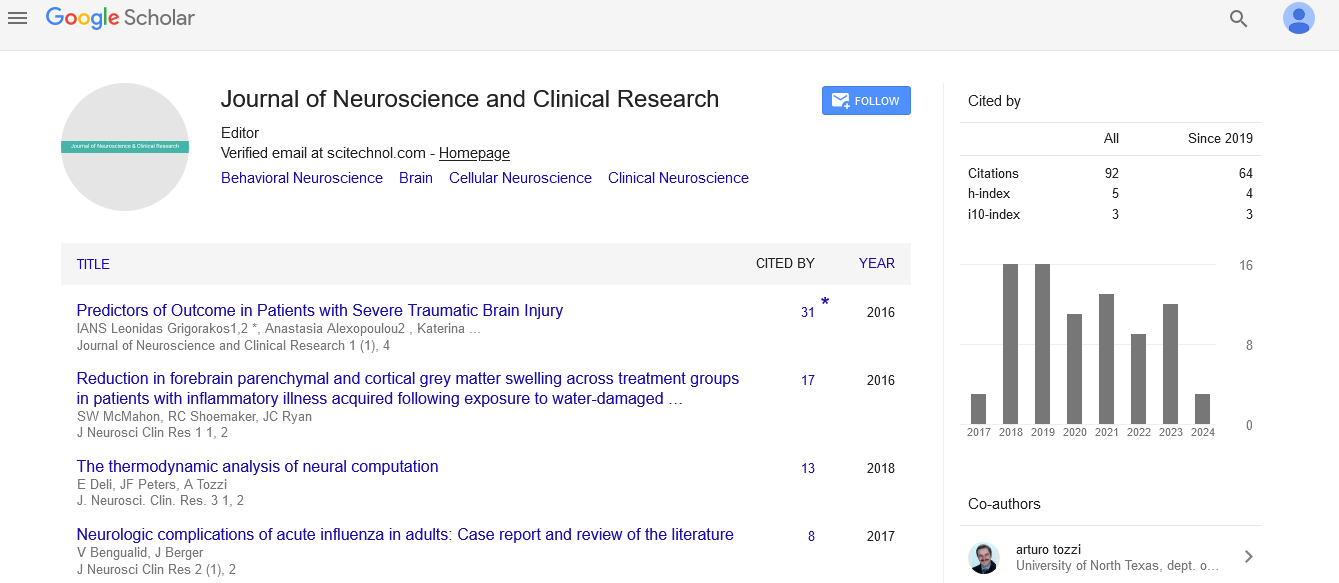Perspective, J Neurosci Clin Res Vol: 9 Issue: 2
Neurotransmitter Diversity in Neural Network Signal Transmission
Castañeda Kupriyanov*
1Department of Neurology and Neurological Sciences, Stanford University, Stanford, USA
*Corresponding Author: Castañeda Kupriyanov,
Department of Neurology and
Neurological Sciences, Stanford University, Stanford, USA
E-mail: cakupriyanov@gmail.com
Received date: 28 May, 2024, Manuscript No. JNSCR-24-137126;
Editor assigned date: 30 May, 2024, PreQC No. JNSCR-24-137126 (PQ);
Reviewed date: 14 June, 2024, QC No. JNSCR-24-137126;
Revised date: 21 June, 2024, Manuscript No. JNSCR-24-137126 (R);
Published date: 28 June, 2024, DOI: 10.4172/Jnscr.1000197
Citation: Kupriyanov C (2024) Neurotransmitter Diversity in Neural Network Signal Transmission. J Neurosci Clin Res 9:2.
Description
The human body is a marvel of intricate systems and processes, and one of the most complex and vital systems is the nervous system. Central to this system are neurons, the specialized cells responsible for transmitting signals between different parts of the body. These signals are essential for everything from simple reflexes to complex cognitive processes. Understanding how neurons communicate is key to comprehending how our bodies function and respond to the environment. Neurons are uniquely structured to carry out their signaling functions. A typical neuron consists of three main parts: The cell body (soma), dendrites, and an axon. The cell body contains the nucleus and other organelles essential for the cell's life processes. Dendrites branch out from the cell body, acting like antennas to receive signals from other neurons. The axon is a long, slender projection that transmits signals away from the cell body to other neurons, muscles, or glands.
The process of signal transmission in neurons involves both electrical and chemical mechanisms. In its resting state, a neuron has a negative electrical charge inside compared to the outside. This difference in charge, known as the resting potential, is maintained by ion channels and pumps in the neuron's membrane. When a neuron receives a sufficient stimulus, ion channels open, allowing positively charged ions to flow into the cell. This depolarizes the membrane, reversing the charge difference. If the depolarization reaches a certain threshold, it triggers an action potential-a rapid, temporary change in electrical potential that travels along the axon. The action potential travels down the axon in a wave-like manner. This is facilitated by the opening and closing of ion channels along the axon's length. In myelinated axons, the action potential jumps between nodes of Ranvier (gaps in the myelin sheath), speeding up signal transmission through a process called saltatory conduction.
When the action potential reaches the end of the axon (the axon terminal), it triggers the release of neurotransmitters, chemical messengers stored in vesicles. These neurotransmitters are released into the synaptic cleft, the gap between the axon terminal and the dendrite of the next neuron. Neurotransmitters bind to specific receptors on the membrane of the receiving neuron (post-synaptic neuron). This binding can either excite or inhibit the post-synaptic neuron, depending on the type of neurotransmitter and receptor involved. Excitation increases the likelihood of the post-synaptic neuron firing its own action potential, while inhibition decreases it.
Neurotransmitters plays an important role in the communication between neurons. There are many different types of neurotransmitters, each with specific functions. The primary excitatory neurotransmitter in the brain, involved in learning and memory. The primary inhibitory neurotransmitter, which helps regulate neuronal excitability and prevent overstimulation. Involved in reward, motivation, and motor control. Imbalances in dopamine levels are linked to conditions like Parkinson’s disease and schizophrenia. Plays a role in mood regulation, sleep, and appetite. Serotonin imbalances are associated with depression and anxiety disorders. Involved in muscle activation, learning, and memory. It is the main neurotransmitter at neuromuscular junctions.
Disruptions in neural communication can lead to a variety of neurological and psychiatric disorders. For instance, Multiple Sclerosis (MS) involves the degradation of the myelin sheath, leading to impaired signal transmission. Epilepsy is characterized by abnormal, excessive neuronal activity. Neurodegenerative diseases like Alzheimer’s disease result from the progressive loss of neuron function and communication. Research into neural communication has led to significant advances in medical science. Techniques like electrophysiology, imaging technologies, and molecular biology have enhanced our understanding of how neurons communicate. These advances have paved the way for new treatments and interventions for neurological disorders. For example, Deep Brain Stimulation (DBS) uses electrical impulses to regulate neural activity in conditions like Parkinson's disease and depression.
Conclusion
The communication highway of neurons is fundamental to our existence, enabling us to perceive, respond to, and interact with the world around us. By understanding the mechanisms of signal transmission in neurons, we can appreciate the complexity of the nervous system and the delicate balance required for its proper function. Ongoing research continues to uncover the intricacies of neural communication, offering hope for improved treatments and therapies for a wide range of neurological conditions.
 Spanish
Spanish  Chinese
Chinese  Russian
Russian  German
German  French
French  Japanese
Japanese  Portuguese
Portuguese  Hindi
Hindi 